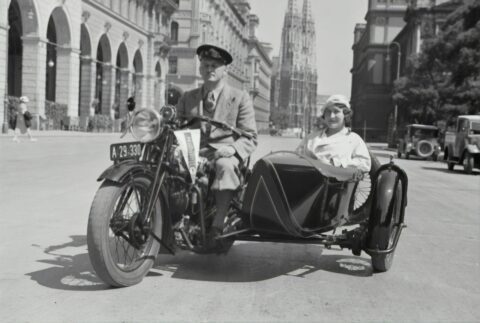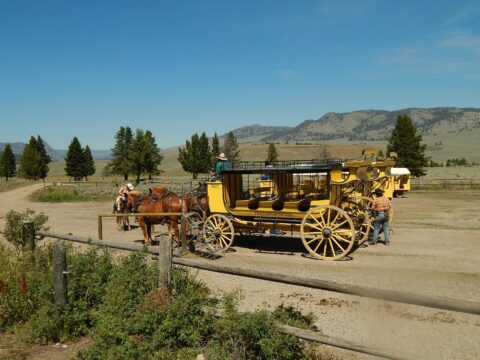Introduction to Transportation and its Evolution
Get ready to take a thrilling journey through time as we explore the fascinating evolution of transportation! From humble beginnings with horses and chariots to the mind-boggling concept of a hyperloop, humanity’s quest for efficient and innovative ways to move has shaped our world in unimaginable ways. Buckle up, because this blog post will take you on an exciting ride through history, highlighting key milestones and technological advancements that have revolutionized the way we travel. So hop aboard as we embark on this unforgettable adventure into the captivating world of transportation!
Ancient Modes of Transportation – From Horses to Chariots
Ancient Modes of Transportation – From Horses to Chariots
Transportation has come a long way since its humble beginnings. In ancient times, people relied on the power and speed of horses to travel from one place to another. These magnificent creatures were not only used for transportation but also for agriculture and warfare.
Horse-drawn chariots were another mode of transportation that emerged during this time. With their sleek design and ability to carry multiple passengers, chariots revolutionized the way people traveled. They provided a faster and more efficient means of getting around, especially in battle.
As civilizations advanced, so did their transportation methods. Ancient Egyptians constructed intricate canal systems that allowed them to transport goods via barges along the Nile River. This innovation was a game-changer as it facilitated trade between different regions.
In Mesopotamia, boats made from reeds were used to navigate through rivers and canals. These primitive vessels allowed people to transport goods over long distances, connecting communities and fostering cultural exchange.
The ancient Greeks introduced yet another remarkable mode of transportation – ships powered by sails. These vessels enabled sailors to explore vast oceans and establish trade routes with distant lands.
Each ancient civilization had its own unique approach to transportation, reflecting their needs and resources available. While horses played a crucial role in enabling mobility on land, other civilizations turned to waterways or even utilized animal-powered carts for transporting heavy loads.
These early forms of transportation laid the foundation for future innovations in mobility that we enjoy today.
The Industrial Revolution and the Birth of Modern Transportation
During the Industrial Revolution, transportation underwent a dramatic transformation that would forever change society. This era saw the birth of modern transportation as we know it today.
One of the key developments during this time was the invention and widespread use of steam-powered locomotives. These iron horses revolutionized land travel, allowing people and goods to be transported faster and more efficiently than ever before. The construction of extensive railway networks connected cities and industries, fostering economic growth and facilitating trade.
At sea, steamships replaced traditional sailing vessels, offering greater speed and reliability for long-distance travel. With these advancements in maritime technology, global trade expanded exponentially as ships could now carry larger cargoes over longer distances in shorter periods of time.
Furthermore, the invention of the internal combustion engine paved the way for automobiles to become a common mode of transportation. These vehicles provided unprecedented mobility for individuals and transformed urban landscapes with their networks of roads.
The Industrial Revolution also gave rise to major improvements in infrastructure such as canals and bridges, further enhancing connectivity between regions. Canals became crucial waterways for transporting goods across countries while bridges enabled efficient passage over rivers and valleys.
The Industrial Revolution played an instrumental role in shaping modern transportation systems by introducing innovations such as steam-powered locomotives, steamships, automobiles, canals, bridges among others. Its impact on society cannot be overstated – it fueled economic growth by enabling faster movement of people and goods both domestically and internationally. This period marked a turning point in history where transport became not only essential but transformative for societies around the world
The Impact of the Automobile on Society
The Impact of the Automobile on Society
The invention of the automobile revolutionized society in countless ways. Suddenly, people had a convenient and efficient means of transportation that allowed them to travel longer distances in less time. This newfound mobility transformed how people lived, worked, and interacted with one another.
With the rise of automobiles came increased opportunities for economic growth. The automotive industry boomed, creating jobs and stimulating local economies. People could now commute farther distances for work or explore new job opportunities in different cities.
Cars also brought about changes in social dynamics. They provided a sense of freedom and independence, allowing individuals to go wherever they pleased without relying on public transportation or others for rides. This newfound autonomy gave rise to the concept of road trips – adventures on wheels that allowed people to explore new places at their own pace.
Furthermore, automobiles played a significant role in shaping urban planning and infrastructure development. Roads were constructed to accommodate cars, leading to the expansion of cities and suburban areas as commuting became easier than ever before.
However, along with these positive impacts came challenges as well. The widespread use of automobiles contributed significantly to air pollution and environmental degradation. Traffic congestion became a growing problem in many urban areas, affecting both productivity and quality-of-life.
Despite these drawbacks, there is no denying that automobiles have had an indelible impact on society. Through their influence on commerce, culture, and personal freedom – cars continue shape our world today.
The Rise of Air Travel and its Influence on Globalization
The Rise of Air Travel and its Influence on Globalization
Air travel has revolutionized the way we connect with the world. It has bridged vast distances, bringing people closer than ever before. With the advent of commercial airlines, traveling across continents became faster and more accessible to a wider range of people.
Gone are the days when long voyages were reserved for adventurers or explorers. Now, anyone with a passport can board a plane and soar through the skies towards their destination. This accessibility has opened up new opportunities for business, tourism, and cultural exchange.
One significant impact of air travel is its role in fueling globalization. As flight routes expanded and airlines offered affordable fares, it became easier for goods and services to be transported internationally. Companies could reach markets across borders in record time, accelerating global trade.
Furthermore, air travel has facilitated cultural exchange on an unprecedented scale. People from different countries can now easily visit each other’s homelands, immersing themselves in diverse cultures and forging connections that transcend geographical boundaries.
Not only does air travel foster economic growth by facilitating trade and tourism but it also promotes understanding among nations by encouraging personal interactions between individuals from various backgrounds.
In addition to connecting people globally, air travel has also played a vital role in emergency response efforts during natural disasters or humanitarian crises. The ability to swiftly transport supplies or medical personnel to affected areas can make all the difference in saving lives.
While there are concerns about environmental impacts associated with aviation emissions, ongoing efforts are being made to develop sustainable aviation solutions such as biofuels or electric planes that aim to minimize carbon footprints without compromising connectivity.
As we look forward into the future of transportation technology like Hyperloop systems or flying cars may shape how we navigate our globe even further – but one thing remains certain: air travel will continue playing a pivotal role in connecting our world!
So fasten your seatbelts because whether you’re jetting off for a business meeting or embarking on an adventure, the sky is no longer
Innovations in Public Transportation – Trains, Subways, and Buses
Public transportation has come a long way since the days of horse-drawn carriages and steam locomotives. Today, we have trains, subways, and buses that efficiently transport millions of people every day.
Trains revolutionized public transportation in the 19th century. They provided a faster and more reliable means of travel compared to horse-drawn carriages. The invention of the steam engine made it possible for trains to cover long distances at impressive speeds. This innovation opened up new opportunities for trade, commerce, and tourism.
Subways emerged as a solution to urban congestion in the early 20th century. These underground rail systems allowed cities to expand their transportation networks without taking up valuable surface space. Subways are not only efficient but also environmentally friendly as they reduce traffic congestion and air pollution.
Buses have been around for centuries but have undergone significant improvements over time. From horse-drawn omnibuses to electric-powered buses today, these vehicles offer affordable and flexible transportation options. Buses connect communities that may not have access to other forms of public transportation like trains or subways.
Innovations continue to shape public transportation as technology advances further. We now see the integration of smart card payment systems, GPS monitoring for real-time tracking, and even electric or hybrid-powered vehicles for reduced carbon emissions.
The future holds even more exciting possibilities with concepts like driverless buses and hyperloop technology on the horizon. These innovations promise faster travel times with minimal environmental impact.
The evolution of public transportation continues unabated as we strive towards creating sustainable modes of travel that serve our growing population’s needs efficiently! So hop on board this incredible journey through history where progress never stops!
Future of Transportation – Hyperloop, Flying Cars, and Beyond
Future of Transportation – Hyperloop, Flying Cars, and Beyond
As we look ahead to the future of transportation, it’s impossible not to be excited about the incredible innovations that lie on the horizon. One such innovation is the concept of the Hyperloop – a revolutionary mode of transport that could change the way we travel forever. Imagine zooming through a vacuum-sealed tube at speeds exceeding 700 miles per hour, reaching your destination in mere minutes. It may sound like science fiction, but companies like Elon Musk’s SpaceX and Virgin Hyperloop are already working towards making this dream a reality.
But it doesn’t stop there. Another exciting development in transportation is the advent of flying cars. The idea of taking to the skies for our daily commute may seem far-fetched, but companies like Uber and Airbus are investing heavily in developing prototypes and infrastructure for this futuristic mode of transportation. Can you imagine soaring above traffic jams or bypassing congested highways? With autonomous technology rapidly advancing, flying cars may soon become an accessible option for urban mobility.
Beyond these remarkable advancements, other ideas like vertical takeoff and landing vehicles (VTOLs) offer even more possibilities for fast and efficient travel within cities. These electric-powered aircraft have shorter range capabilities than airplanes but can vertically lift off from small spaces like helipads or rooftops.
And let’s not forget about self-driving vehicles! While still being perfected with ongoing research and development efforts by companies such as Tesla and Waymo (a subsidiary of Google’s parent company), autonomous cars hold great promise in terms of reducing accidents caused by human error while improving traffic flow efficiency.
The future holds endless potential when it comes to revolutionizing transportation. From hyperloops to flying cars and beyond, these new technologies will undoubtedly reshape how we move from point A to point B in ways we can only begin to imagine right now.
Environmental Impact of Transportation and Efforts
Environmental Impact of Transportation and Efforts
As we marvel at the incredible advancements in transportation throughout history, it is important to consider the environmental impact that these developments have had on our planet. The growth of transportation systems has undoubtedly contributed to pollution, climate change, and resource depletion.
The burning of fossil fuels by vehicles has been a major contributor to air pollution and greenhouse gas emissions. This not only affects the quality of the air we breathe but also contributes to global warming and climate change. Additionally, the extraction and processing of raw materials for vehicle manufacturing further deplete natural resources.
Fortunately, there have been significant efforts made to mitigate these negative effects. Governments around the world are implementing stricter emission standards for vehicles, encouraging the use of electric cars, and investing in renewable energy sources for transportation. Public transport systems are being improved with cleaner technologies such as hybrid or electric buses and trains.
In recent years, there has also been a growing interest in alternative modes of transportation that are eco-friendly. One exciting development is the Hyperloop – a high-speed transit system that uses magnetic levitation technology to propel pods through low-pressure tubes. This mode of transport has minimal environmental impact as it operates on electricity instead of fossil fuels.
Furthermore, innovations like flying cars powered by electricity could revolutionize urban mobility while reducing carbon emissions associated with traditional road travel. These futuristic concepts may seem far-fetched now but hold promise for a greener future if developed sustainably.
Another crucial aspect is promoting sustainable practices among individuals. Carpooling or using shared ride-hailing services can help reduce congestion on roads as well as lower individual carbon footprints. Cycling or walking short distances instead of relying solely on motorized vehicles can have significant positive impacts on personal health as well as reduce overall emissions.
It’s clear that addressing the environmental challenges caused by transportation requires collective action from governments, industries, and individuals alike. With continued innovation in clean energy technologies, increased adoption of sustainable practices, and a commitment to reducing emissions, we can create a future where transportation







